Unilever's HR Practices and Their Impact on Organizational Growth
VerifiedAdded on 2023/06/05
|9
|2760
|231
Report
AI Summary
This report provides an in-depth analysis of Unilever Plc's human resource practices and their contribution to the company's organizational success. It begins by describing Unilever's business, products, and global presence, highlighting its commitment to sustainability. The report then examines the importance of organizational design theory in shaping Unilever's structure and strategy, focusing on tall, matrix, network, and functional organizational structures, detailing both the advantages and disadvantages of these structures within Unilever's context. Furthermore, the analysis explores various approaches used by Unilever to enhance employee skills, dedication, and talent retention, including fostering a positive work environment, implementing reward and recognition programs, promoting employee involvement and engagement, and investing in skill development. Finally, the report discusses contemporary knowledge and emerging HR development approaches, such as hybrid work models and power skill development, that support Unilever's HR strategies. This document is available on Desklib, a platform offering a wide range of study tools and resources for students.
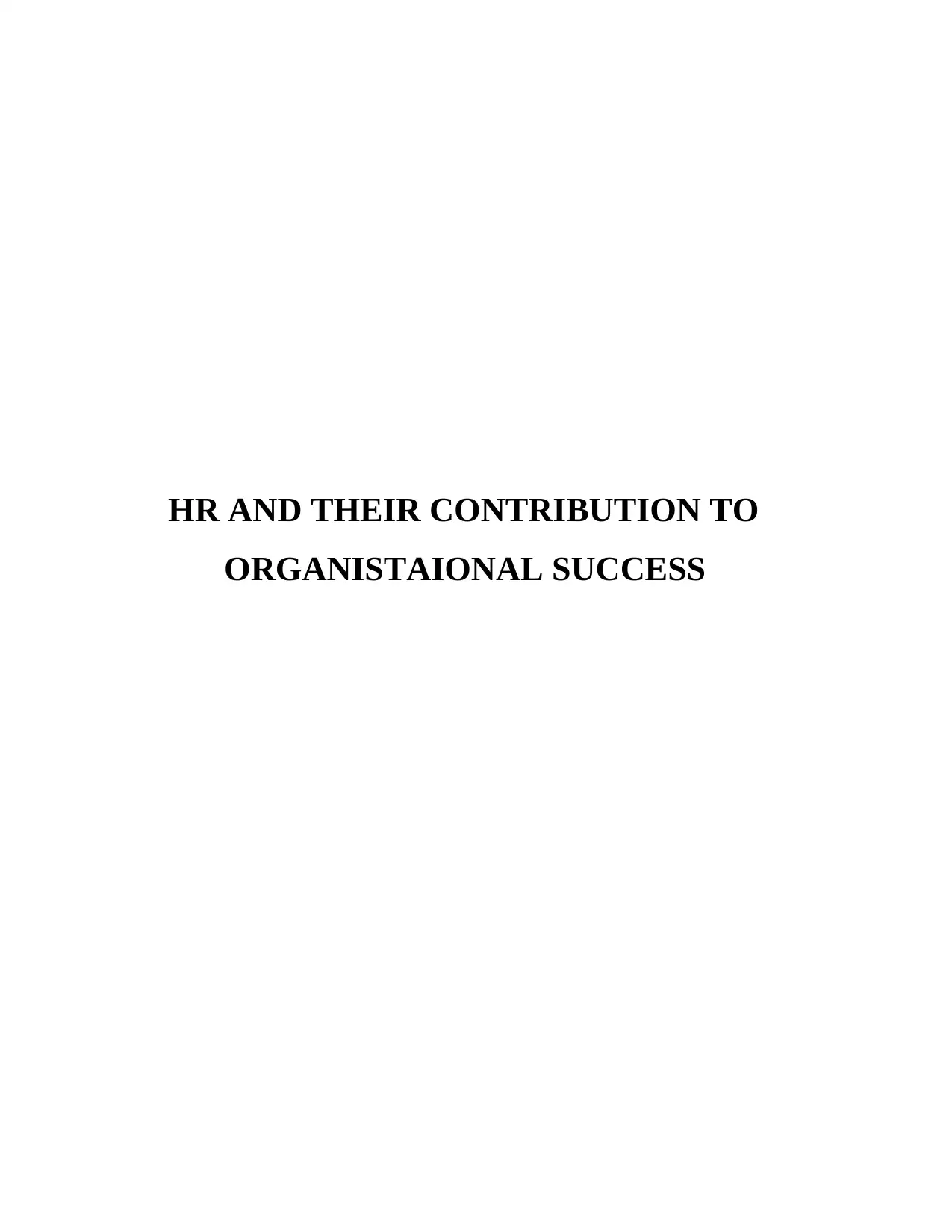
HR AND THEIR CONTRIBUTION TO
ORGANISTAIONAL SUCCESS
ORGANISTAIONAL SUCCESS
Paraphrase This Document
Need a fresh take? Get an instant paraphrase of this document with our AI Paraphraser
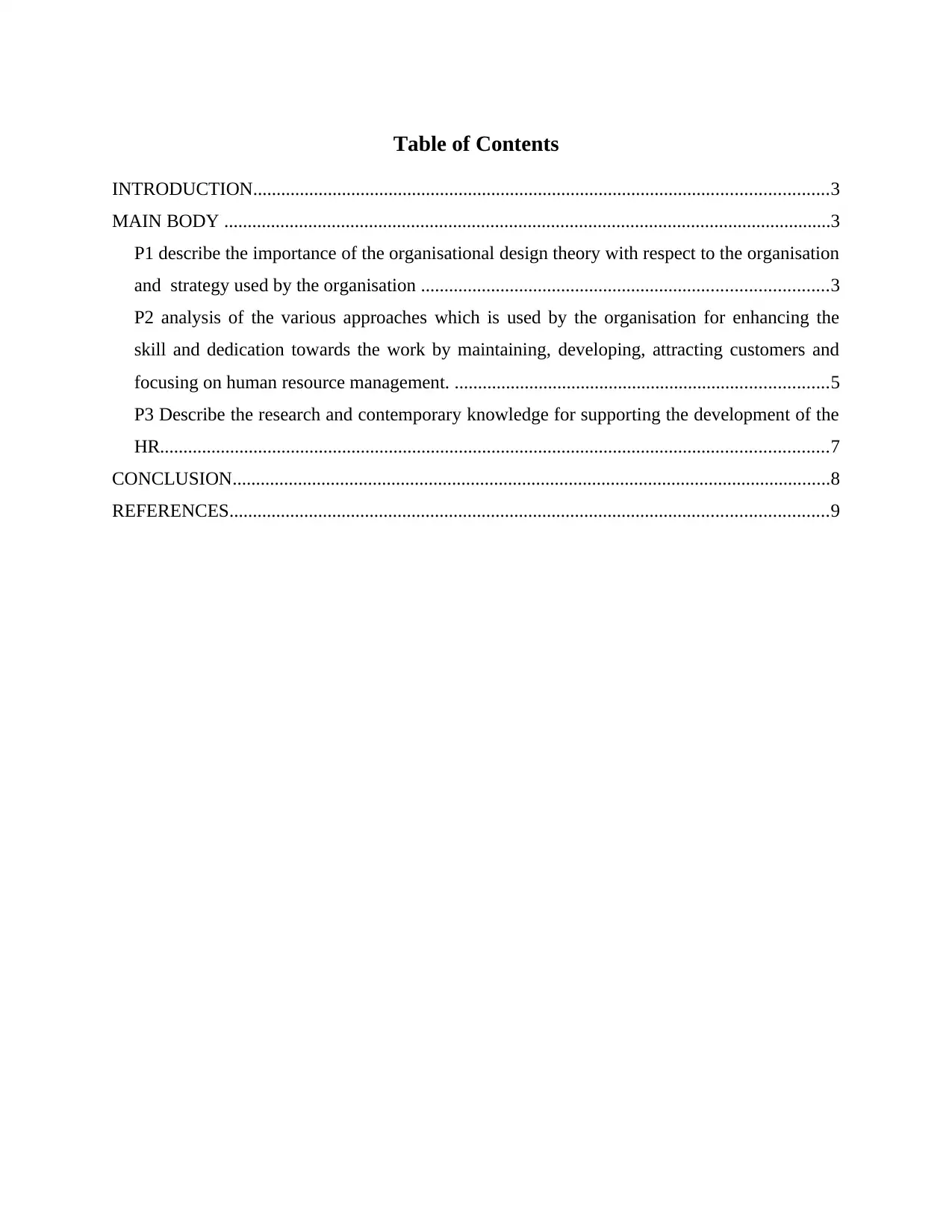
Table of Contents
INTRODUCTION...........................................................................................................................3
MAIN BODY ..................................................................................................................................3
P1 describe the importance of the organisational design theory with respect to the organisation
and strategy used by the organisation .......................................................................................3
P2 analysis of the various approaches which is used by the organisation for enhancing the
skill and dedication towards the work by maintaining, developing, attracting customers and
focusing on human resource management. ................................................................................5
P3 Describe the research and contemporary knowledge for supporting the development of the
HR...............................................................................................................................................7
CONCLUSION................................................................................................................................8
REFERENCES................................................................................................................................9
INTRODUCTION...........................................................................................................................3
MAIN BODY ..................................................................................................................................3
P1 describe the importance of the organisational design theory with respect to the organisation
and strategy used by the organisation .......................................................................................3
P2 analysis of the various approaches which is used by the organisation for enhancing the
skill and dedication towards the work by maintaining, developing, attracting customers and
focusing on human resource management. ................................................................................5
P3 Describe the research and contemporary knowledge for supporting the development of the
HR...............................................................................................................................................7
CONCLUSION................................................................................................................................8
REFERENCES................................................................................................................................9
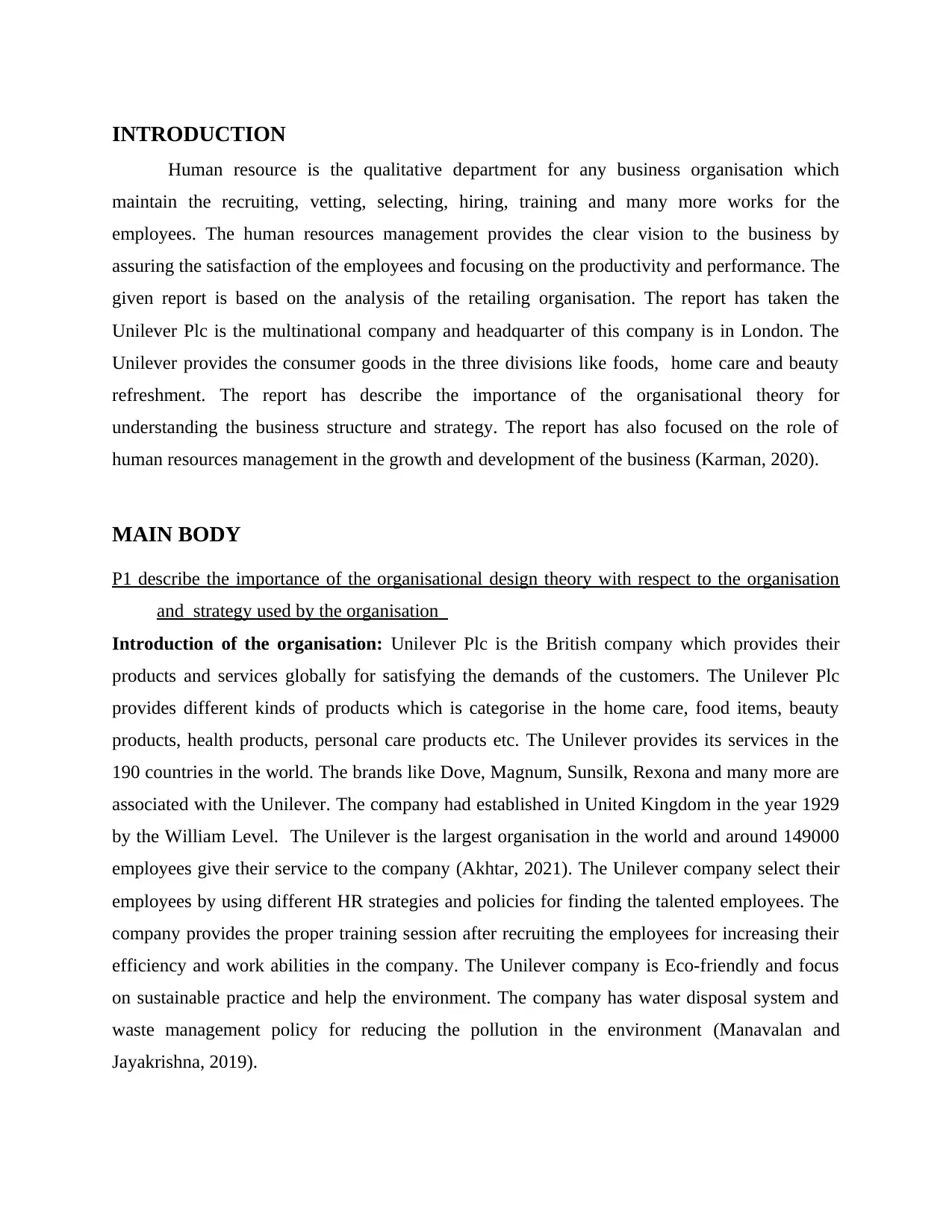
INTRODUCTION
Human resource is the qualitative department for any business organisation which
maintain the recruiting, vetting, selecting, hiring, training and many more works for the
employees. The human resources management provides the clear vision to the business by
assuring the satisfaction of the employees and focusing on the productivity and performance. The
given report is based on the analysis of the retailing organisation. The report has taken the
Unilever Plc is the multinational company and headquarter of this company is in London. The
Unilever provides the consumer goods in the three divisions like foods, home care and beauty
refreshment. The report has describe the importance of the organisational theory for
understanding the business structure and strategy. The report has also focused on the role of
human resources management in the growth and development of the business (Karman, 2020).
MAIN BODY
P1 describe the importance of the organisational design theory with respect to the organisation
and strategy used by the organisation
Introduction of the organisation: Unilever Plc is the British company which provides their
products and services globally for satisfying the demands of the customers. The Unilever Plc
provides different kinds of products which is categorise in the home care, food items, beauty
products, health products, personal care products etc. The Unilever provides its services in the
190 countries in the world. The brands like Dove, Magnum, Sunsilk, Rexona and many more are
associated with the Unilever. The company had established in United Kingdom in the year 1929
by the William Level. The Unilever is the largest organisation in the world and around 149000
employees give their service to the company (Akhtar, 2021). The Unilever company select their
employees by using different HR strategies and policies for finding the talented employees. The
company provides the proper training session after recruiting the employees for increasing their
efficiency and work abilities in the company. The Unilever company is Eco-friendly and focus
on sustainable practice and help the environment. The company has water disposal system and
waste management policy for reducing the pollution in the environment (Manavalan and
Jayakrishna, 2019).
Human resource is the qualitative department for any business organisation which
maintain the recruiting, vetting, selecting, hiring, training and many more works for the
employees. The human resources management provides the clear vision to the business by
assuring the satisfaction of the employees and focusing on the productivity and performance. The
given report is based on the analysis of the retailing organisation. The report has taken the
Unilever Plc is the multinational company and headquarter of this company is in London. The
Unilever provides the consumer goods in the three divisions like foods, home care and beauty
refreshment. The report has describe the importance of the organisational theory for
understanding the business structure and strategy. The report has also focused on the role of
human resources management in the growth and development of the business (Karman, 2020).
MAIN BODY
P1 describe the importance of the organisational design theory with respect to the organisation
and strategy used by the organisation
Introduction of the organisation: Unilever Plc is the British company which provides their
products and services globally for satisfying the demands of the customers. The Unilever Plc
provides different kinds of products which is categorise in the home care, food items, beauty
products, health products, personal care products etc. The Unilever provides its services in the
190 countries in the world. The brands like Dove, Magnum, Sunsilk, Rexona and many more are
associated with the Unilever. The company had established in United Kingdom in the year 1929
by the William Level. The Unilever is the largest organisation in the world and around 149000
employees give their service to the company (Akhtar, 2021). The Unilever company select their
employees by using different HR strategies and policies for finding the talented employees. The
company provides the proper training session after recruiting the employees for increasing their
efficiency and work abilities in the company. The Unilever company is Eco-friendly and focus
on sustainable practice and help the environment. The company has water disposal system and
waste management policy for reducing the pollution in the environment (Manavalan and
Jayakrishna, 2019).
⊘ This is a preview!⊘
Do you want full access?
Subscribe today to unlock all pages.

Trusted by 1+ million students worldwide
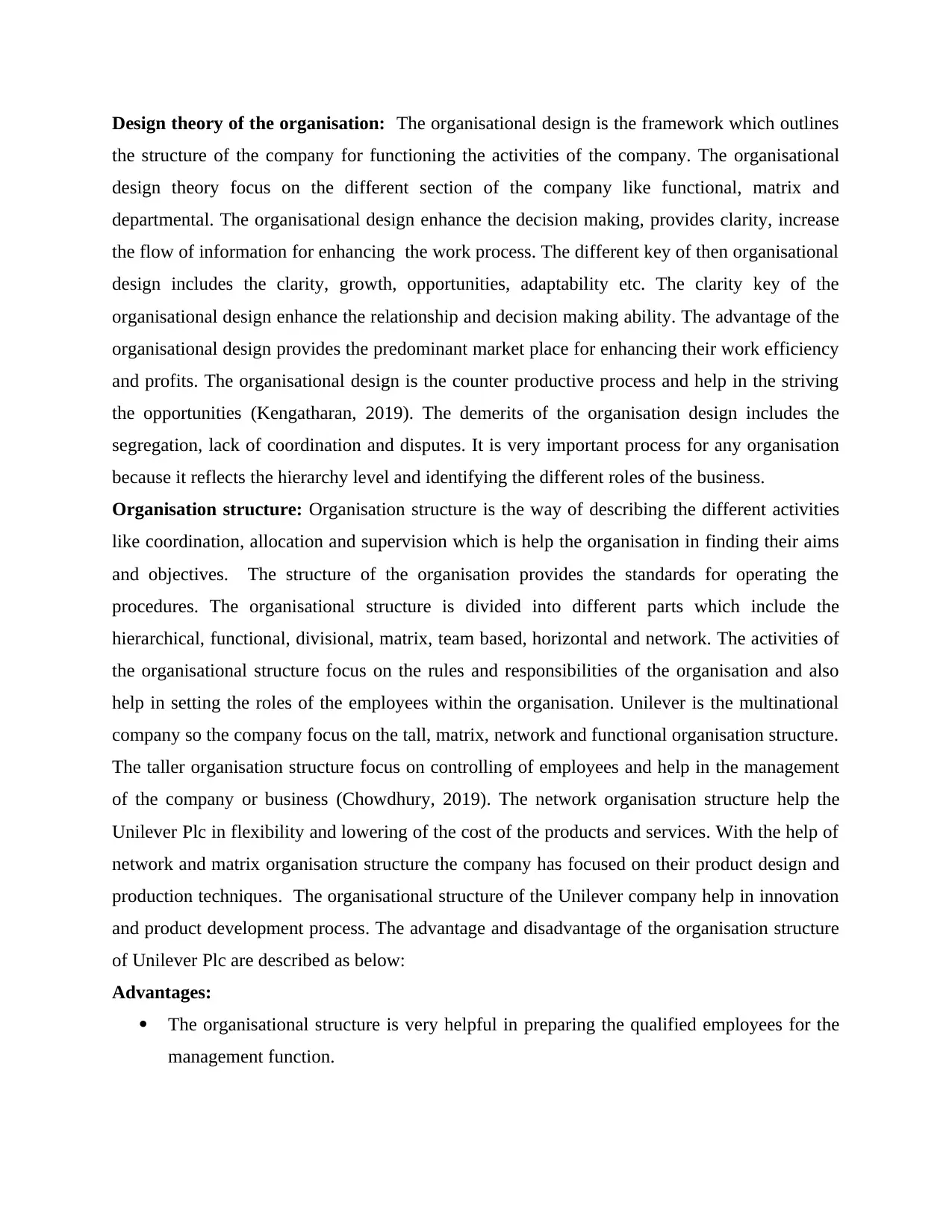
Design theory of the organisation: The organisational design is the framework which outlines
the structure of the company for functioning the activities of the company. The organisational
design theory focus on the different section of the company like functional, matrix and
departmental. The organisational design enhance the decision making, provides clarity, increase
the flow of information for enhancing the work process. The different key of then organisational
design includes the clarity, growth, opportunities, adaptability etc. The clarity key of the
organisational design enhance the relationship and decision making ability. The advantage of the
organisational design provides the predominant market place for enhancing their work efficiency
and profits. The organisational design is the counter productive process and help in the striving
the opportunities (Kengatharan, 2019). The demerits of the organisation design includes the
segregation, lack of coordination and disputes. It is very important process for any organisation
because it reflects the hierarchy level and identifying the different roles of the business.
Organisation structure: Organisation structure is the way of describing the different activities
like coordination, allocation and supervision which is help the organisation in finding their aims
and objectives. The structure of the organisation provides the standards for operating the
procedures. The organisational structure is divided into different parts which include the
hierarchical, functional, divisional, matrix, team based, horizontal and network. The activities of
the organisational structure focus on the rules and responsibilities of the organisation and also
help in setting the roles of the employees within the organisation. Unilever is the multinational
company so the company focus on the tall, matrix, network and functional organisation structure.
The taller organisation structure focus on controlling of employees and help in the management
of the company or business (Chowdhury, 2019). The network organisation structure help the
Unilever Plc in flexibility and lowering of the cost of the products and services. With the help of
network and matrix organisation structure the company has focused on their product design and
production techniques. The organisational structure of the Unilever company help in innovation
and product development process. The advantage and disadvantage of the organisation structure
of Unilever Plc are described as below:
Advantages:
The organisational structure is very helpful in preparing the qualified employees for the
management function.
the structure of the company for functioning the activities of the company. The organisational
design theory focus on the different section of the company like functional, matrix and
departmental. The organisational design enhance the decision making, provides clarity, increase
the flow of information for enhancing the work process. The different key of then organisational
design includes the clarity, growth, opportunities, adaptability etc. The clarity key of the
organisational design enhance the relationship and decision making ability. The advantage of the
organisational design provides the predominant market place for enhancing their work efficiency
and profits. The organisational design is the counter productive process and help in the striving
the opportunities (Kengatharan, 2019). The demerits of the organisation design includes the
segregation, lack of coordination and disputes. It is very important process for any organisation
because it reflects the hierarchy level and identifying the different roles of the business.
Organisation structure: Organisation structure is the way of describing the different activities
like coordination, allocation and supervision which is help the organisation in finding their aims
and objectives. The structure of the organisation provides the standards for operating the
procedures. The organisational structure is divided into different parts which include the
hierarchical, functional, divisional, matrix, team based, horizontal and network. The activities of
the organisational structure focus on the rules and responsibilities of the organisation and also
help in setting the roles of the employees within the organisation. Unilever is the multinational
company so the company focus on the tall, matrix, network and functional organisation structure.
The taller organisation structure focus on controlling of employees and help in the management
of the company or business (Chowdhury, 2019). The network organisation structure help the
Unilever Plc in flexibility and lowering of the cost of the products and services. With the help of
network and matrix organisation structure the company has focused on their product design and
production techniques. The organisational structure of the Unilever company help in innovation
and product development process. The advantage and disadvantage of the organisation structure
of Unilever Plc are described as below:
Advantages:
The organisational structure is very helpful in preparing the qualified employees for the
management function.
Paraphrase This Document
Need a fresh take? Get an instant paraphrase of this document with our AI Paraphraser
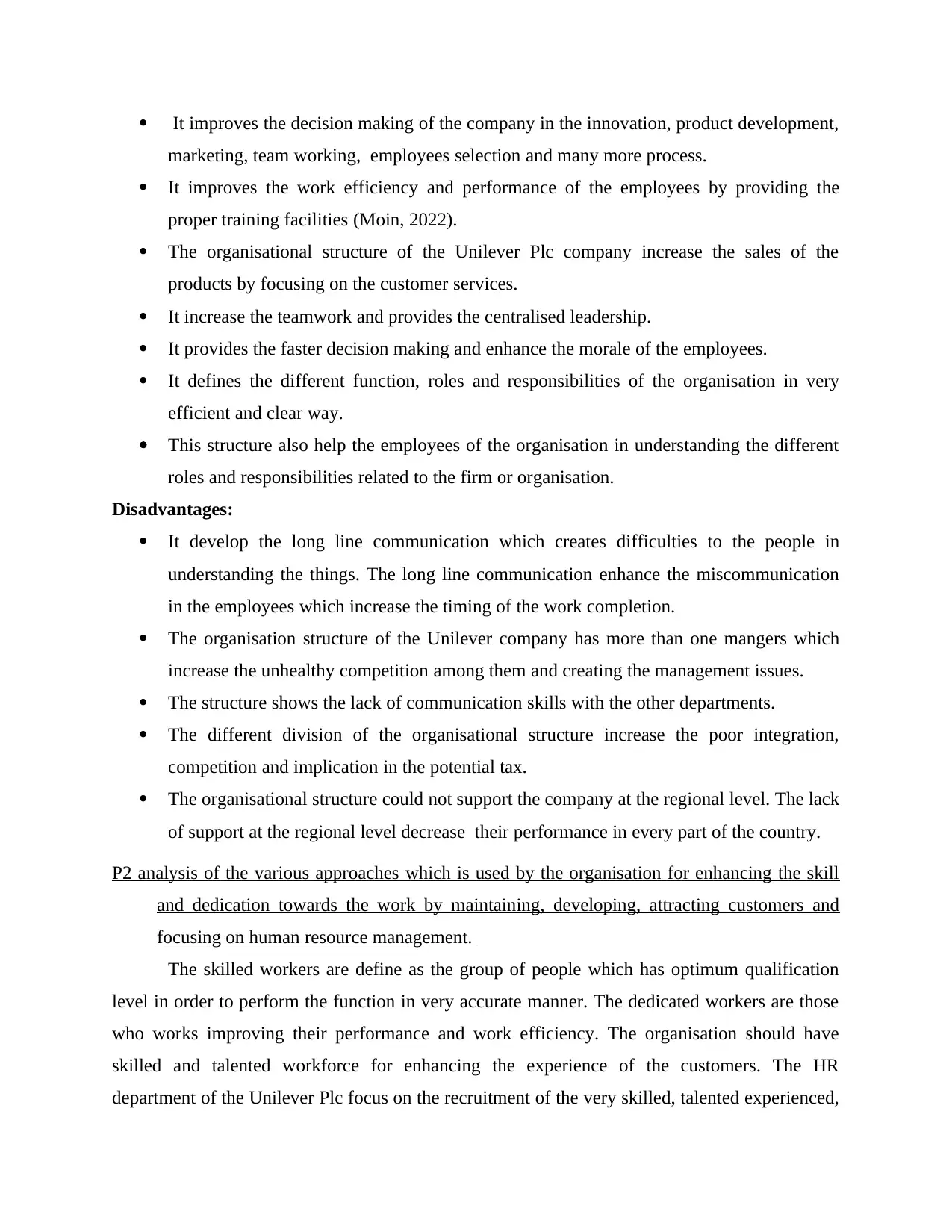
It improves the decision making of the company in the innovation, product development,
marketing, team working, employees selection and many more process.
It improves the work efficiency and performance of the employees by providing the
proper training facilities (Moin, 2022).
The organisational structure of the Unilever Plc company increase the sales of the
products by focusing on the customer services.
It increase the teamwork and provides the centralised leadership.
It provides the faster decision making and enhance the morale of the employees.
It defines the different function, roles and responsibilities of the organisation in very
efficient and clear way.
This structure also help the employees of the organisation in understanding the different
roles and responsibilities related to the firm or organisation.
Disadvantages:
It develop the long line communication which creates difficulties to the people in
understanding the things. The long line communication enhance the miscommunication
in the employees which increase the timing of the work completion.
The organisation structure of the Unilever company has more than one mangers which
increase the unhealthy competition among them and creating the management issues.
The structure shows the lack of communication skills with the other departments.
The different division of the organisational structure increase the poor integration,
competition and implication in the potential tax.
The organisational structure could not support the company at the regional level. The lack
of support at the regional level decrease their performance in every part of the country.
P2 analysis of the various approaches which is used by the organisation for enhancing the skill
and dedication towards the work by maintaining, developing, attracting customers and
focusing on human resource management.
The skilled workers are define as the group of people which has optimum qualification
level in order to perform the function in very accurate manner. The dedicated workers are those
who works improving their performance and work efficiency. The organisation should have
skilled and talented workforce for enhancing the experience of the customers. The HR
department of the Unilever Plc focus on the recruitment of the very skilled, talented experienced,
marketing, team working, employees selection and many more process.
It improves the work efficiency and performance of the employees by providing the
proper training facilities (Moin, 2022).
The organisational structure of the Unilever Plc company increase the sales of the
products by focusing on the customer services.
It increase the teamwork and provides the centralised leadership.
It provides the faster decision making and enhance the morale of the employees.
It defines the different function, roles and responsibilities of the organisation in very
efficient and clear way.
This structure also help the employees of the organisation in understanding the different
roles and responsibilities related to the firm or organisation.
Disadvantages:
It develop the long line communication which creates difficulties to the people in
understanding the things. The long line communication enhance the miscommunication
in the employees which increase the timing of the work completion.
The organisation structure of the Unilever company has more than one mangers which
increase the unhealthy competition among them and creating the management issues.
The structure shows the lack of communication skills with the other departments.
The different division of the organisational structure increase the poor integration,
competition and implication in the potential tax.
The organisational structure could not support the company at the regional level. The lack
of support at the regional level decrease their performance in every part of the country.
P2 analysis of the various approaches which is used by the organisation for enhancing the skill
and dedication towards the work by maintaining, developing, attracting customers and
focusing on human resource management.
The skilled workers are define as the group of people which has optimum qualification
level in order to perform the function in very accurate manner. The dedicated workers are those
who works improving their performance and work efficiency. The organisation should have
skilled and talented workforce for enhancing the experience of the customers. The HR
department of the Unilever Plc focus on the recruitment of the very skilled, talented experienced,
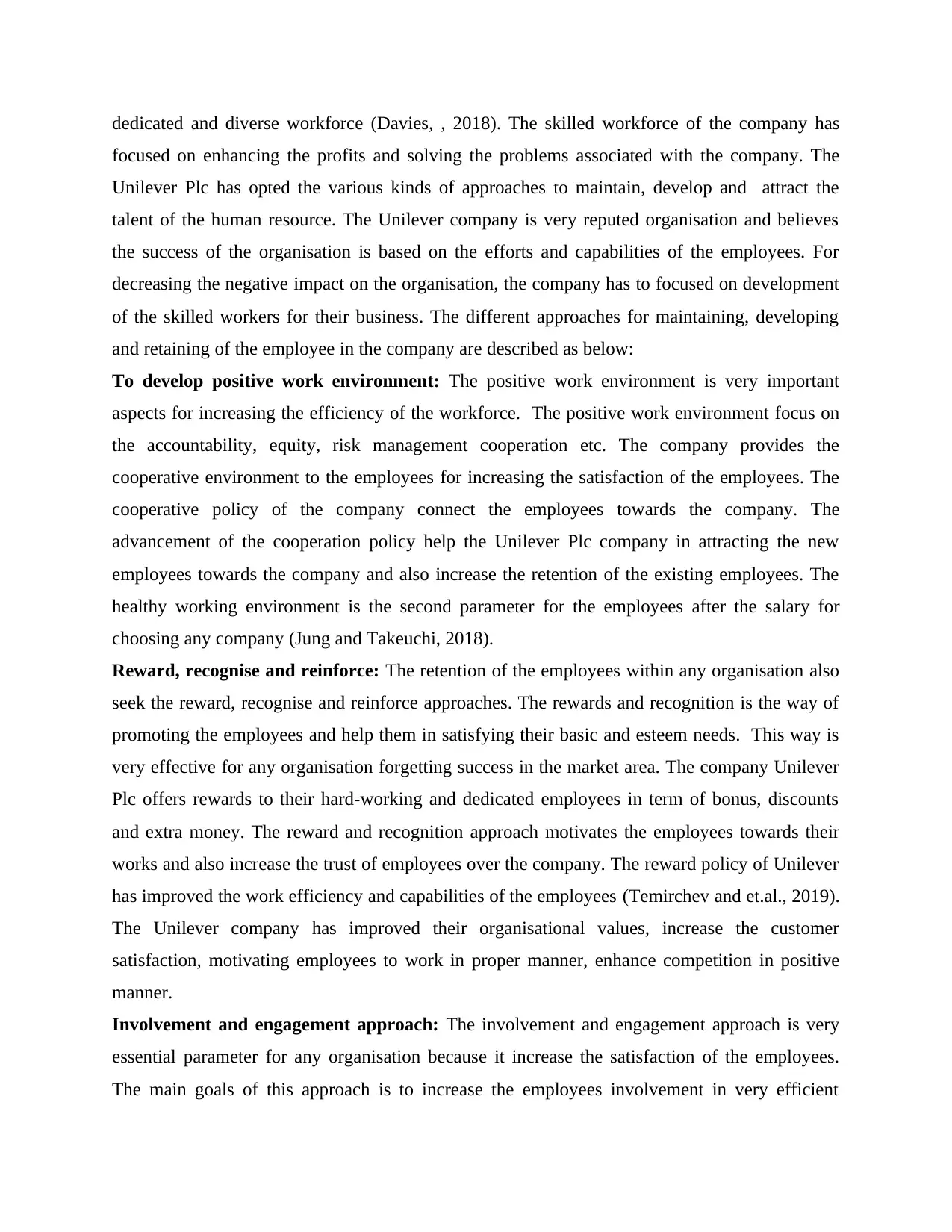
dedicated and diverse workforce (Davies, , 2018). The skilled workforce of the company has
focused on enhancing the profits and solving the problems associated with the company. The
Unilever Plc has opted the various kinds of approaches to maintain, develop and attract the
talent of the human resource. The Unilever company is very reputed organisation and believes
the success of the organisation is based on the efforts and capabilities of the employees. For
decreasing the negative impact on the organisation, the company has to focused on development
of the skilled workers for their business. The different approaches for maintaining, developing
and retaining of the employee in the company are described as below:
To develop positive work environment: The positive work environment is very important
aspects for increasing the efficiency of the workforce. The positive work environment focus on
the accountability, equity, risk management cooperation etc. The company provides the
cooperative environment to the employees for increasing the satisfaction of the employees. The
cooperative policy of the company connect the employees towards the company. The
advancement of the cooperation policy help the Unilever Plc company in attracting the new
employees towards the company and also increase the retention of the existing employees. The
healthy working environment is the second parameter for the employees after the salary for
choosing any company (Jung and Takeuchi, 2018).
Reward, recognise and reinforce: The retention of the employees within any organisation also
seek the reward, recognise and reinforce approaches. The rewards and recognition is the way of
promoting the employees and help them in satisfying their basic and esteem needs. This way is
very effective for any organisation forgetting success in the market area. The company Unilever
Plc offers rewards to their hard-working and dedicated employees in term of bonus, discounts
and extra money. The reward and recognition approach motivates the employees towards their
works and also increase the trust of employees over the company. The reward policy of Unilever
has improved the work efficiency and capabilities of the employees (Temirchev and et.al., 2019).
The Unilever company has improved their organisational values, increase the customer
satisfaction, motivating employees to work in proper manner, enhance competition in positive
manner.
Involvement and engagement approach: The involvement and engagement approach is very
essential parameter for any organisation because it increase the satisfaction of the employees.
The main goals of this approach is to increase the employees involvement in very efficient
focused on enhancing the profits and solving the problems associated with the company. The
Unilever Plc has opted the various kinds of approaches to maintain, develop and attract the
talent of the human resource. The Unilever company is very reputed organisation and believes
the success of the organisation is based on the efforts and capabilities of the employees. For
decreasing the negative impact on the organisation, the company has to focused on development
of the skilled workers for their business. The different approaches for maintaining, developing
and retaining of the employee in the company are described as below:
To develop positive work environment: The positive work environment is very important
aspects for increasing the efficiency of the workforce. The positive work environment focus on
the accountability, equity, risk management cooperation etc. The company provides the
cooperative environment to the employees for increasing the satisfaction of the employees. The
cooperative policy of the company connect the employees towards the company. The
advancement of the cooperation policy help the Unilever Plc company in attracting the new
employees towards the company and also increase the retention of the existing employees. The
healthy working environment is the second parameter for the employees after the salary for
choosing any company (Jung and Takeuchi, 2018).
Reward, recognise and reinforce: The retention of the employees within any organisation also
seek the reward, recognise and reinforce approaches. The rewards and recognition is the way of
promoting the employees and help them in satisfying their basic and esteem needs. This way is
very effective for any organisation forgetting success in the market area. The company Unilever
Plc offers rewards to their hard-working and dedicated employees in term of bonus, discounts
and extra money. The reward and recognition approach motivates the employees towards their
works and also increase the trust of employees over the company. The reward policy of Unilever
has improved the work efficiency and capabilities of the employees (Temirchev and et.al., 2019).
The Unilever company has improved their organisational values, increase the customer
satisfaction, motivating employees to work in proper manner, enhance competition in positive
manner.
Involvement and engagement approach: The involvement and engagement approach is very
essential parameter for any organisation because it increase the satisfaction of the employees.
The main goals of this approach is to increase the employees involvement in very efficient
⊘ This is a preview!⊘
Do you want full access?
Subscribe today to unlock all pages.

Trusted by 1+ million students worldwide
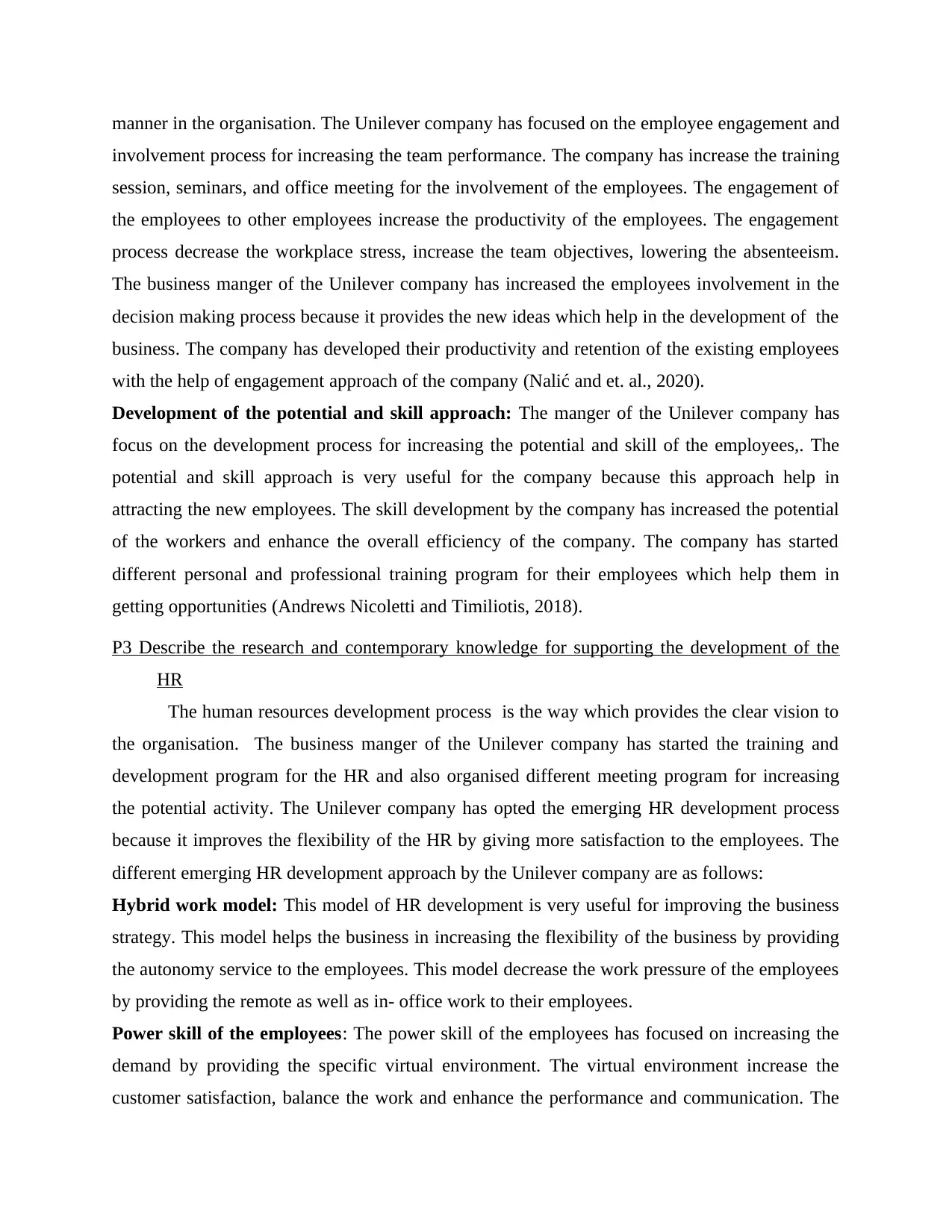
manner in the organisation. The Unilever company has focused on the employee engagement and
involvement process for increasing the team performance. The company has increase the training
session, seminars, and office meeting for the involvement of the employees. The engagement of
the employees to other employees increase the productivity of the employees. The engagement
process decrease the workplace stress, increase the team objectives, lowering the absenteeism.
The business manger of the Unilever company has increased the employees involvement in the
decision making process because it provides the new ideas which help in the development of the
business. The company has developed their productivity and retention of the existing employees
with the help of engagement approach of the company (Nalić and et. al., 2020).
Development of the potential and skill approach: The manger of the Unilever company has
focus on the development process for increasing the potential and skill of the employees,. The
potential and skill approach is very useful for the company because this approach help in
attracting the new employees. The skill development by the company has increased the potential
of the workers and enhance the overall efficiency of the company. The company has started
different personal and professional training program for their employees which help them in
getting opportunities (Andrews Nicoletti and Timiliotis, 2018).
P3 Describe the research and contemporary knowledge for supporting the development of the
HR
The human resources development process is the way which provides the clear vision to
the organisation. The business manger of the Unilever company has started the training and
development program for the HR and also organised different meeting program for increasing
the potential activity. The Unilever company has opted the emerging HR development process
because it improves the flexibility of the HR by giving more satisfaction to the employees. The
different emerging HR development approach by the Unilever company are as follows:
Hybrid work model: This model of HR development is very useful for improving the business
strategy. This model helps the business in increasing the flexibility of the business by providing
the autonomy service to the employees. This model decrease the work pressure of the employees
by providing the remote as well as in- office work to their employees.
Power skill of the employees: The power skill of the employees has focused on increasing the
demand by providing the specific virtual environment. The virtual environment increase the
customer satisfaction, balance the work and enhance the performance and communication. The
involvement process for increasing the team performance. The company has increase the training
session, seminars, and office meeting for the involvement of the employees. The engagement of
the employees to other employees increase the productivity of the employees. The engagement
process decrease the workplace stress, increase the team objectives, lowering the absenteeism.
The business manger of the Unilever company has increased the employees involvement in the
decision making process because it provides the new ideas which help in the development of the
business. The company has developed their productivity and retention of the existing employees
with the help of engagement approach of the company (Nalić and et. al., 2020).
Development of the potential and skill approach: The manger of the Unilever company has
focus on the development process for increasing the potential and skill of the employees,. The
potential and skill approach is very useful for the company because this approach help in
attracting the new employees. The skill development by the company has increased the potential
of the workers and enhance the overall efficiency of the company. The company has started
different personal and professional training program for their employees which help them in
getting opportunities (Andrews Nicoletti and Timiliotis, 2018).
P3 Describe the research and contemporary knowledge for supporting the development of the
HR
The human resources development process is the way which provides the clear vision to
the organisation. The business manger of the Unilever company has started the training and
development program for the HR and also organised different meeting program for increasing
the potential activity. The Unilever company has opted the emerging HR development process
because it improves the flexibility of the HR by giving more satisfaction to the employees. The
different emerging HR development approach by the Unilever company are as follows:
Hybrid work model: This model of HR development is very useful for improving the business
strategy. This model helps the business in increasing the flexibility of the business by providing
the autonomy service to the employees. This model decrease the work pressure of the employees
by providing the remote as well as in- office work to their employees.
Power skill of the employees: The power skill of the employees has focused on increasing the
demand by providing the specific virtual environment. The virtual environment increase the
customer satisfaction, balance the work and enhance the performance and communication. The
Paraphrase This Document
Need a fresh take? Get an instant paraphrase of this document with our AI Paraphraser
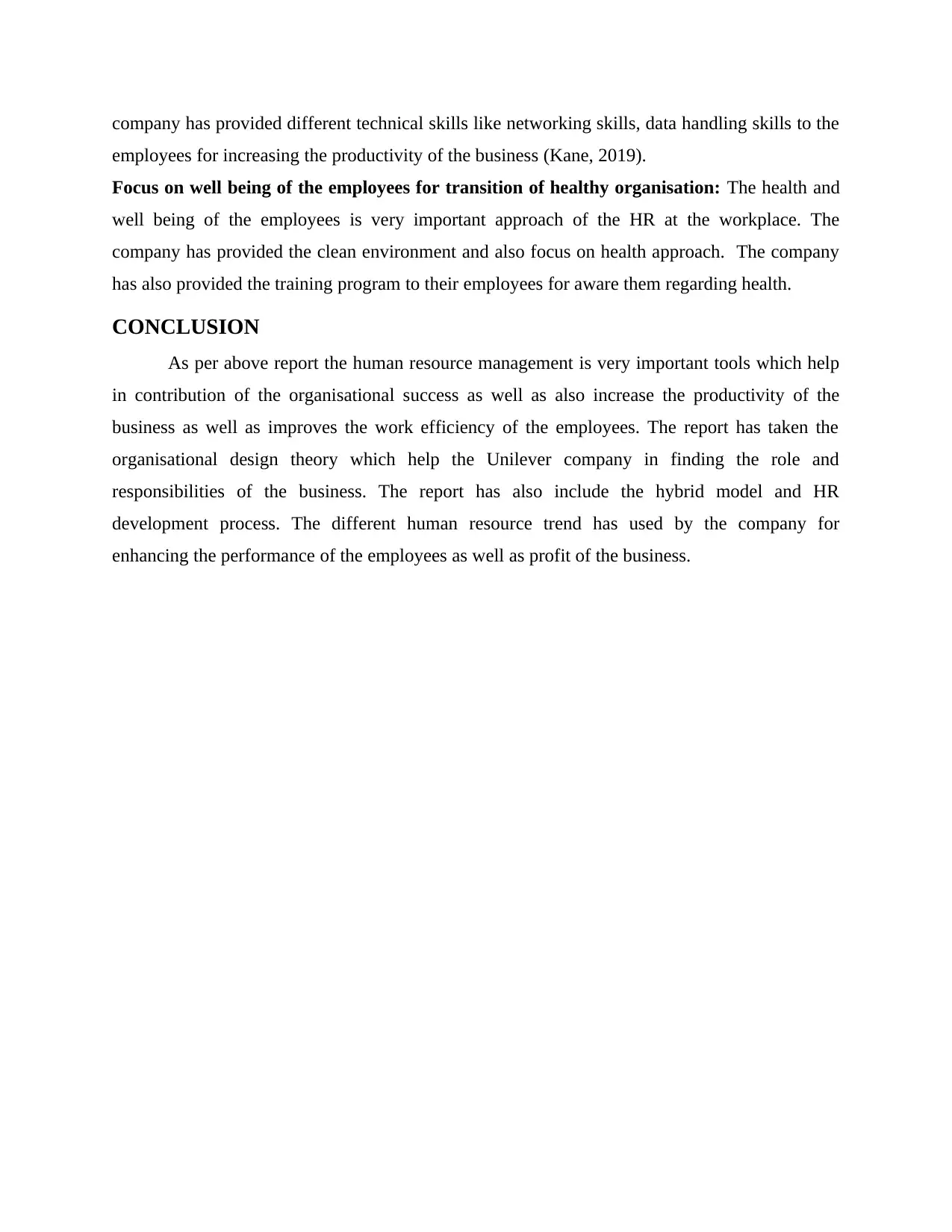
company has provided different technical skills like networking skills, data handling skills to the
employees for increasing the productivity of the business (Kane, 2019).
Focus on well being of the employees for transition of healthy organisation: The health and
well being of the employees is very important approach of the HR at the workplace. The
company has provided the clean environment and also focus on health approach. The company
has also provided the training program to their employees for aware them regarding health.
CONCLUSION
As per above report the human resource management is very important tools which help
in contribution of the organisational success as well as also increase the productivity of the
business as well as improves the work efficiency of the employees. The report has taken the
organisational design theory which help the Unilever company in finding the role and
responsibilities of the business. The report has also include the hybrid model and HR
development process. The different human resource trend has used by the company for
enhancing the performance of the employees as well as profit of the business.
employees for increasing the productivity of the business (Kane, 2019).
Focus on well being of the employees for transition of healthy organisation: The health and
well being of the employees is very important approach of the HR at the workplace. The
company has provided the clean environment and also focus on health approach. The company
has also provided the training program to their employees for aware them regarding health.
CONCLUSION
As per above report the human resource management is very important tools which help
in contribution of the organisational success as well as also increase the productivity of the
business as well as improves the work efficiency of the employees. The report has taken the
organisational design theory which help the Unilever company in finding the role and
responsibilities of the business. The report has also include the hybrid model and HR
development process. The different human resource trend has used by the company for
enhancing the performance of the employees as well as profit of the business.
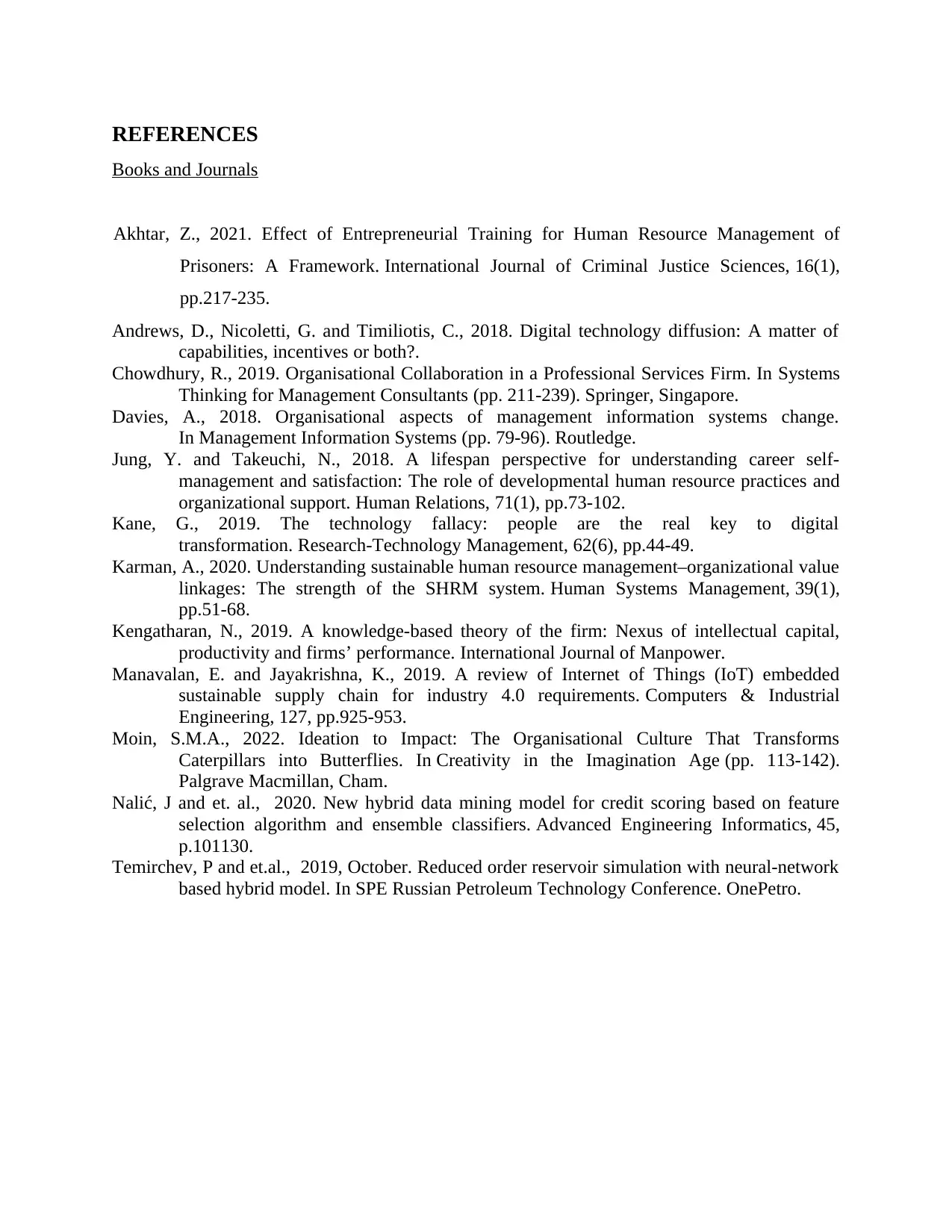
REFERENCES
Books and Journals
Akhtar, Z., 2021. Effect of Entrepreneurial Training for Human Resource Management of
Prisoners: A Framework. International Journal of Criminal Justice Sciences, 16(1),
pp.217-235.
Andrews, D., Nicoletti, G. and Timiliotis, C., 2018. Digital technology diffusion: A matter of
capabilities, incentives or both?.
Chowdhury, R., 2019. Organisational Collaboration in a Professional Services Firm. In Systems
Thinking for Management Consultants (pp. 211-239). Springer, Singapore.
Davies, A., 2018. Organisational aspects of management information systems change.
In Management Information Systems (pp. 79-96). Routledge.
Jung, Y. and Takeuchi, N., 2018. A lifespan perspective for understanding career self-
management and satisfaction: The role of developmental human resource practices and
organizational support. Human Relations, 71(1), pp.73-102.
Kane, G., 2019. The technology fallacy: people are the real key to digital
transformation. Research-Technology Management, 62(6), pp.44-49.
Karman, A., 2020. Understanding sustainable human resource management–organizational value
linkages: The strength of the SHRM system. Human Systems Management, 39(1),
pp.51-68.
Kengatharan, N., 2019. A knowledge-based theory of the firm: Nexus of intellectual capital,
productivity and firms’ performance. International Journal of Manpower.
Manavalan, E. and Jayakrishna, K., 2019. A review of Internet of Things (IoT) embedded
sustainable supply chain for industry 4.0 requirements. Computers & Industrial
Engineering, 127, pp.925-953.
Moin, S.M.A., 2022. Ideation to Impact: The Organisational Culture That Transforms
Caterpillars into Butterflies. In Creativity in the Imagination Age (pp. 113-142).
Palgrave Macmillan, Cham.
Nalić, J and et. al., 2020. New hybrid data mining model for credit scoring based on feature
selection algorithm and ensemble classifiers. Advanced Engineering Informatics, 45,
p.101130.
Temirchev, P and et.al., 2019, October. Reduced order reservoir simulation with neural-network
based hybrid model. In SPE Russian Petroleum Technology Conference. OnePetro.
Books and Journals
Akhtar, Z., 2021. Effect of Entrepreneurial Training for Human Resource Management of
Prisoners: A Framework. International Journal of Criminal Justice Sciences, 16(1),
pp.217-235.
Andrews, D., Nicoletti, G. and Timiliotis, C., 2018. Digital technology diffusion: A matter of
capabilities, incentives or both?.
Chowdhury, R., 2019. Organisational Collaboration in a Professional Services Firm. In Systems
Thinking for Management Consultants (pp. 211-239). Springer, Singapore.
Davies, A., 2018. Organisational aspects of management information systems change.
In Management Information Systems (pp. 79-96). Routledge.
Jung, Y. and Takeuchi, N., 2018. A lifespan perspective for understanding career self-
management and satisfaction: The role of developmental human resource practices and
organizational support. Human Relations, 71(1), pp.73-102.
Kane, G., 2019. The technology fallacy: people are the real key to digital
transformation. Research-Technology Management, 62(6), pp.44-49.
Karman, A., 2020. Understanding sustainable human resource management–organizational value
linkages: The strength of the SHRM system. Human Systems Management, 39(1),
pp.51-68.
Kengatharan, N., 2019. A knowledge-based theory of the firm: Nexus of intellectual capital,
productivity and firms’ performance. International Journal of Manpower.
Manavalan, E. and Jayakrishna, K., 2019. A review of Internet of Things (IoT) embedded
sustainable supply chain for industry 4.0 requirements. Computers & Industrial
Engineering, 127, pp.925-953.
Moin, S.M.A., 2022. Ideation to Impact: The Organisational Culture That Transforms
Caterpillars into Butterflies. In Creativity in the Imagination Age (pp. 113-142).
Palgrave Macmillan, Cham.
Nalić, J and et. al., 2020. New hybrid data mining model for credit scoring based on feature
selection algorithm and ensemble classifiers. Advanced Engineering Informatics, 45,
p.101130.
Temirchev, P and et.al., 2019, October. Reduced order reservoir simulation with neural-network
based hybrid model. In SPE Russian Petroleum Technology Conference. OnePetro.
⊘ This is a preview!⊘
Do you want full access?
Subscribe today to unlock all pages.

Trusted by 1+ million students worldwide
1 out of 9
Related Documents
Your All-in-One AI-Powered Toolkit for Academic Success.
+13062052269
info@desklib.com
Available 24*7 on WhatsApp / Email
![[object Object]](/_next/static/media/star-bottom.7253800d.svg)
Unlock your academic potential
Copyright © 2020–2025 A2Z Services. All Rights Reserved. Developed and managed by ZUCOL.




